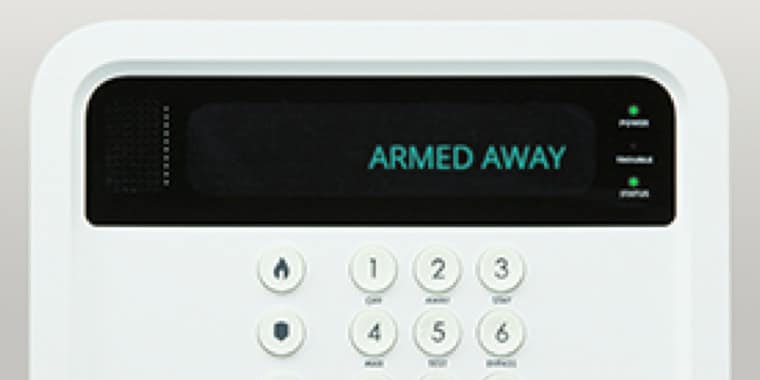Here are three benefits to smart home lighting:
1. Brighten up pathways
2. Adjust the light for mood and sleep
3. Improve your home's energy efficiency
When you're caught up in the daily rush of work, family activities or errands, you may not give the lighting in your home a second thought. But smart home technology can automate your exterior and interior lighting in convenient ways that can improve both your safety and sleep cycles, as well as increase your home's energy efficiency.
Brighten up pathways
 Let's start with safety. In a 2016 study, researchers reported that people felt safest in outdoor environments brightly lit by white LEDs, as opposed to yellow sodium lights.1 ADT's Smart home technology can be set to light up your driveway and front yard when you arrive home from work. If you are leaving town for the weekend, you can also program the lights—both exterior and interior—to turn on and off, suggesting to would-be burglars that someone is home.
Let's start with safety. In a 2016 study, researchers reported that people felt safest in outdoor environments brightly lit by white LEDs, as opposed to yellow sodium lights.1 ADT's Smart home technology can be set to light up your driveway and front yard when you arrive home from work. If you are leaving town for the weekend, you can also program the lights—both exterior and interior—to turn on and off, suggesting to would-be burglars that someone is home.
The benefits of smart lighting your home also include improving physical safety. Every year, more than 37 million falls worldwide are severe enough that they require medical attention. While you may think that elderly people are the only ones at risk for falling, young adults aged 15 to 29 years are the next group at risk, followed by children aged 15 years or younger.2
Other factors outside of age can lead to missteps, too.3 Things like arthritis, chronic pain, diabetes, Parkinson's disease, or medications such as sedatives or antidepressants, can make people susceptible to tripping—especially if the ground is uneven, cluttered or covered in ice or snow. A well-lit entryway creates a safe path to your door.
Adjust the light for mood and sleep
 The intensity of lighting can affect your mood and sleep patterns. A recent study from scientists at the University of Toronto Scarborough found that human emotions are experienced more intensely under bright lights.4 If you're feeling overwhelmed or stressed, then dimming the lights in your home can lower the intensity of such feelings.
The intensity of lighting can affect your mood and sleep patterns. A recent study from scientists at the University of Toronto Scarborough found that human emotions are experienced more intensely under bright lights.4 If you're feeling overwhelmed or stressed, then dimming the lights in your home can lower the intensity of such feelings.
Dimmer lights can also improve sleep patterns. A hormone in your body called melatonin naturally increases in the evening, inducing sleep.5 Overly bright lights can delay the release of the hormone and delay sleep. Use your home's smart lighting system to automatically dim lights an hour or so before you want to go to bed. The muted light will give you a visual reminder that it's time to wind down and signal your body's endocrine system to release melatonin.
Improve your home's energy efficiency

Health and restfulness are two important benefits of a smart light system, but if that doesn't convince you, then perhaps improving your home's energy efficiency will. In the United States, residential lighting consumed about 129 billion kilowatt hours in 2016, or about 10 percent of total amount of electricity used in the residential sector.6 Depending on the state you live in, you may be spending more than $5,000 annually on electricity.7 One of the most cost-effective ways to reduce electricity consumption is to switch to LED light bulbs. LED light bulbs use up to 80 percent less energy than other bulbs and can last up to 25 times longer.8
Smart home lighting systems not only come with LED lights, but also with sensors that detect movement or the presence of a person. This means that lights come on only when you need them, at the intensity you desire. Never again will you need to fumble for a light switch. Never again will you find yourself under the bed covers wondering if you left the lights on in the other rooms.
ADT Home Security can ensure you enjoy the benefits of a smart home lighting system that offers benefits that go behind security and convenience. A well-lit exterior provides an added layer of safety, especially for those with people who may be at a higher risk than others for falling. Optimizing the lighting inside the home enhances your mood, encourages good sleep patterns and improves the efficiency of your home. It might be time to give smart lighting a second thought.
Bibliography
- Antonio Peña-García, et al. "Impact of public lighting on pedestrians' perception of safety and well-being," Safety Science 78, no. 10 (2015): 142–148, doi: 10.1016/j.ssci.2015.04.009.
- "Falls," World Health Organization, accessed January 24, 2017, http://who.int/mediacentre/factsheets/fs344/en/.
- "Aging & Health A to Z," Health in Aging, accessed January 24, 2017, http://healthinaging.org/aging-and-health-a-to-z/topic:falls/info:causes-and-symptoms/.
- Alison Jing Xua, et al. "Incandescent affect: Turning on the hot emotional system with bright light," Journal of Consumer Psychology 24, no. 2 (2014): 207-216, doi: 10.1016/j.jcps.2013.12.007.
- Kristin Harper, "So Tired in the Morning... The Science of Sleep" Chem Matters Online, last modified January 2015, https://acs.org/content/acs/en/education/resources/highschool/chemmatters/past-issues/archive-2014-2015/the-science-of-sleep.html.
- "How much electricity is used for lighting in the United States?" U.S. Energy Information Administration, accessed January 24, 2017, https://eia.gov/tools/faqs/faq.php?id=99&t=3.
- "How Much Do You Spend on Energy?" U.S. Department of Energy, accessed January 24, 2017, https://energy.gov/maps/how-much-do-you-spend-energy.
- "How Energy-Efficient Light Bulbs Compare with Traditional Incandescents," U.S. Department of Energy, accessed January 24, 2017, https://energy.gov/energysaver/save-electricity-and-fuel/lighting-choices-save-you-money/how-energy-efficient-light.





